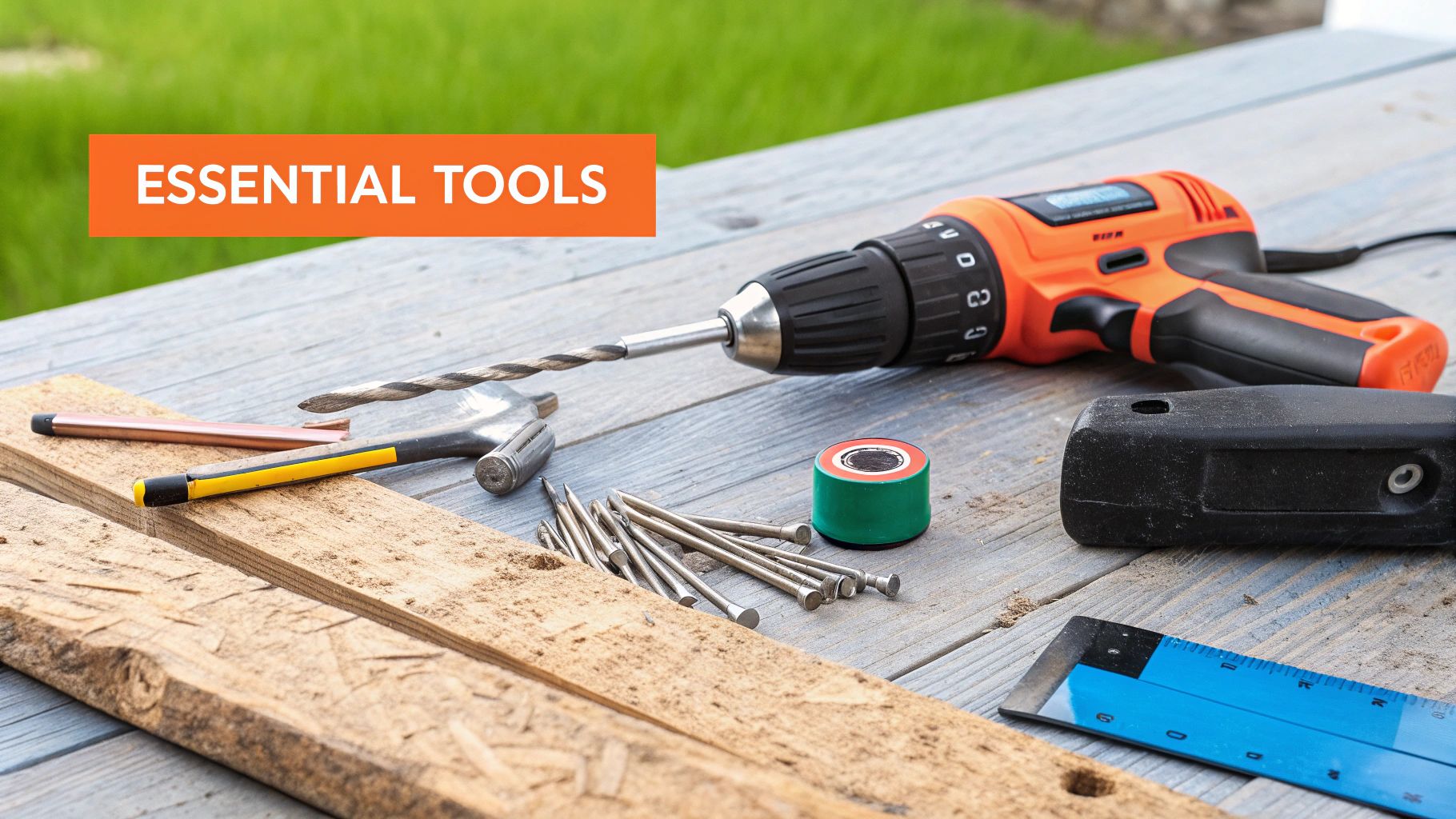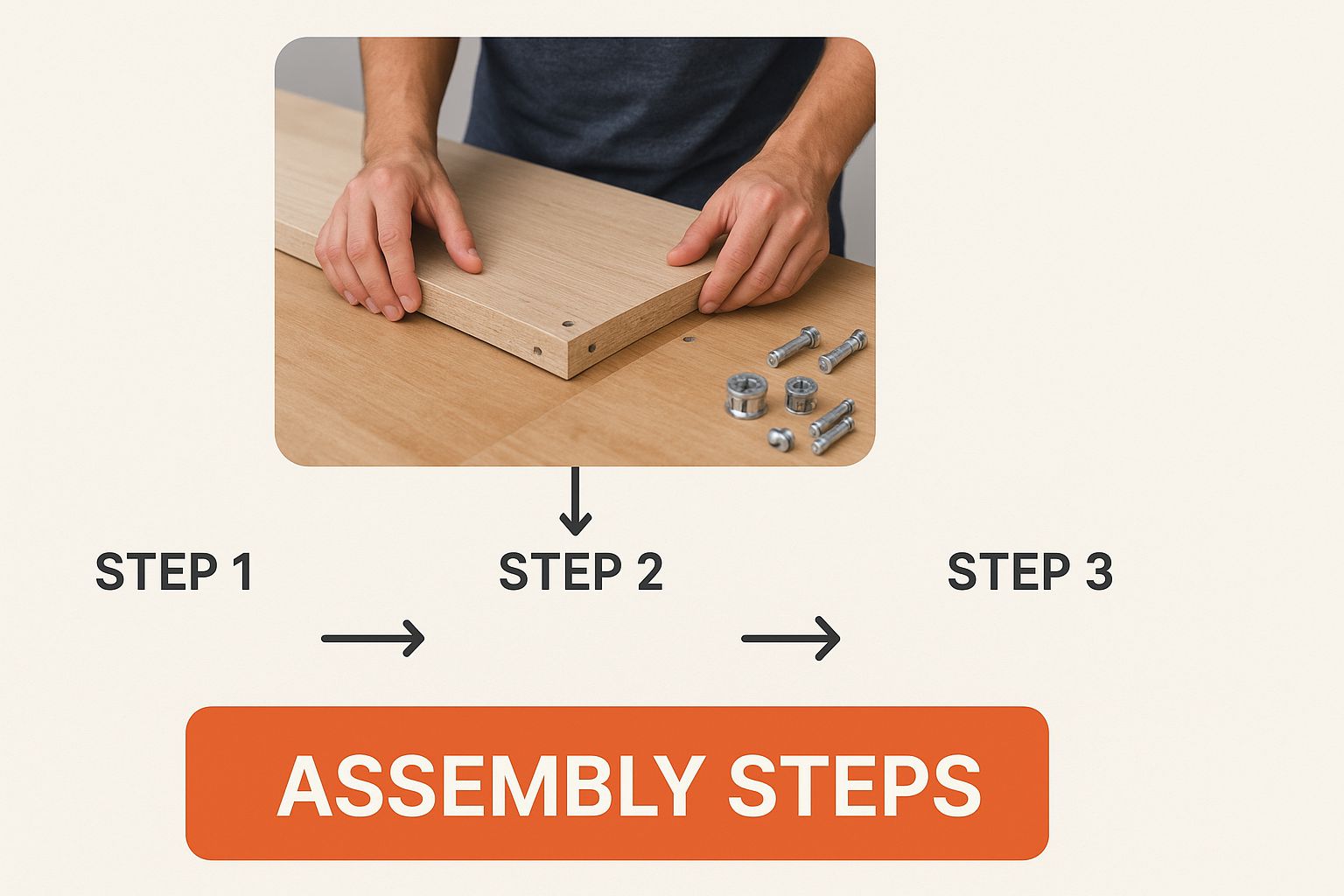-
CALL US:
- (866) 952-3456
Hiring a handyman for furniture assembly is one of the smartest moves you can make. It’s a simple way to get your weekend back and skip the sheer frustration of wrestling with confusing instructions. Instead of a headache, you get a professionally built piece of furniture, assembled correctly and safely from the get-go.
Let's be real—that "easy to assemble" promise on the box is often the biggest lie in retail. You slice it open, and what do you find? A chaotic mess of look-alike panels, a dozen little plastic bags filled with mysterious hardware, and instructions that feel more like abstract art than a helpful guide.
That excitement for your new furniture quickly evaporates, replaced by pure stress.
Think about the busy professional who just wants to unwind after a long week, but instead spends Saturday deciphering cryptic diagrams and searching for a tiny screw that rolled under the sofa. Or the new homeowner, already swamped with unpacking, now facing a mountain of flatpack boxes. In these moments, the real cost of DIY isn't just a few bucks—it's your time, your sanity, and the very real risk of messing it all up.
One misplaced screw or an overtightened bolt can cause a lot more trouble than just a crooked drawer. It can easily crack the particleboard, strip a screw hole, or even void the manufacturer's warranty. Just like that, your brand-new purchase is damaged before you've even used it.
The real value of hiring a professional handyman lies in risk mitigation. They bring the right tools, extensive experience with various brands, and the know-how to navigate even the most complex instructions, protecting your investment and your sanity.
This is especially true for brands known for their particularly tricky designs. If you've ever found yourself staring down a massive IKEA project, our guide on why you should hire a professional to build IKEA furniture for you will probably hit close to home.
Before you commit to spending your weekend on the floor with an Allen key, take a moment to compare your options.
Here’s a quick breakdown of what you're signing up for with each choice.
| Factor | DIY Assembly | Hiring a Handyman |
|---|---|---|
| Time | Can take several hours, often a full day | Typically 1-3 hours, depending on complexity |
| Tools | You need to own or buy the right tools | Professional arrives with everything needed |
| Stress | High potential for frustration and mistakes | Zero stress; the job is handled for you |
| Quality | Risk of wobbly furniture or incorrect assembly | Secure, stable, and correctly built |
| Warranty | Risk of voiding it due to assembly errors | Protects your investment; work is often guaranteed |
Ultimately, hiring a pro isn't about giving up—it's about buying back your time and guaranteeing a job done right.
With online furniture shopping becoming the new normal, it’s no surprise there's been a huge jump in demand for assembly services. The trend is clear, with the global furniture assembly services market projected to hit $374.5 million by 2025. This growth is all thanks to people like you and me who value convenience and smart, time-saving solutions.
When you think about bringing in an expert for any home task, the logic is the same—you're paying for reliability and peace of mind. While the context might be different, it's worth understanding the key benefits of hiring local professionals to see why expertise matters so much.
Choosing a handyman for furniture assembly isn’t an admission of defeat. It’s simply a modern, practical solution for getting the job done right without the hassle.
Alright, let's track down the perfect person for your furniture assembly project. It's not as simple as a quick Google search; you need to know where the real pros hang out.

Finding the right person for the job is about more than just a quick search online. To find a truly qualified and reliable handyman for furniture assembly, you're better off looking in a few different places. This approach helps you build a solid list of potential hires, getting you that much closer to a finished room without the headache.
A great place to start is the online platforms built specifically for this kind of work. Think of them as modern marketplaces connecting you directly with skilled gig workers.
These sites are fantastic because they offer a built-in layer of trust, often including background checks and, most importantly, a public review system. It's a curated, digital version of the old-school Yellow Pages, focused entirely on home services. You can quickly get a feel for the going rates in your town and start a list of names.
While those big platforms are powerful, don't sleep on your local connections. I've found that some of the absolute best, most trustworthy pros are found right in the community, where their reputation is everything.
You can start by getting more specific in your online searches. Instead of just "handyman," try searching for "flatpack furniture builder near me" or "wardrobe assembly service in [Your City]." This will help you uncover smaller, local businesses that specialize in exactly what you need.
Beyond Google, your local community is a goldmine of genuine recommendations you just can't find anywhere else.
A direct referral from someone you trust is often the most reliable way to find a great handyman. People are unlikely to recommend someone unless they had a genuinely positive experience.
Here are a few high-value spots to ask around:
By combining the wide reach of digital platforms with the trusted word-of-mouth from your community, you’ll have a strong list of potential experts. This gives you plenty of options to vet, ensuring you find the perfect handyman for furniture assembly who will get the job done right the first time.
Alright, you've got a shortlist of potential handymen. Now for the most important part. Choosing the right person to assemble your furniture is about more than just finding the lowest price—it's about trusting someone to come into your home and handle your brand-new stuff with care. A little vetting now saves a world of headaches later.
First things first, and this is non-negotiable: check their insurance. Ask to see proof of general liability insurance. This isn't just red tape; it's what protects you if they accidentally scratch your new wood floors or knock a hole in the drywall. A real pro will have this ready to go and won't flinch when you ask.
If someone gets cagey about showing you their insurance, that's your cue to walk away. Seriously. Without it, any accident that happens on your property could become your financial nightmare.
Next up, it’s time to play detective and check their reputation. Sure, online reviews on Google or TaskRabbit are a good place to start, but you have to read between the lines. Look for patterns. Are people consistently mentioning punctuality? Professionalism? The quality of the final build?
Don’t just glance at the star rating; dive into the actual comments. A couple of less-than-stellar reviews aren’t always a deal-breaker, but see how the handyman responded. How someone handles criticism tells you a lot about their professionalism. It’s also a great idea to ask if they have a portfolio or can share photos of similar jobs they've completed. Seeing is believing.

A skilled handyman has a system. They’re methodical, organizing parts and following instructions precisely to avoid mistakes and ensure you end up with a sturdy, perfectly assembled piece of furniture.
With your research in hand, the final step is to actually talk to them. This is your chance to get a feel for their experience and personality. Knowing what to ask is half the battle. This article on 11 essential questions to ask when hiring a service provider has some fantastic general tips, even though it's geared toward movers.
For furniture assembly specifically, I always recommend asking these questions:
Their answers will tell you everything you need to know about their expertise and how they handle the inevitable hiccups. Be wary of anyone asking for all the money upfront or giving you a quote that seems way too good to be true. A trustworthy pro provides a clear, detailed estimate and expects payment only when you’re happy with the finished job.

You’ve done the legwork, vetted your candidates, and are now on the verge of booking a handyman for furniture assembly. The final hurdle? Talking money. Getting a crystal-clear quote upfront is absolutely critical. It’s the one thing that stands between a smooth, stress-free experience and a nasty surprise on the final bill.
This is where you’ll almost always run into two different ways pros price their work. Knowing the difference will help you figure out what makes the most sense for your job.
Most handymen will either charge by the hour or give you a single flat-fee for the whole project. One isn't inherently better than the other; it really just depends on what you need them to build.
An hourly rate often works best for smaller, less predictable jobs. Let's say you just have a nightstand and a few shelves to hang. Paying by the hour is usually more cost-effective here. It gives the handyman a bit of wiggle room if one piece turns out to be more finicky than it looked online.
On the other hand, a flat-fee structure gives you total cost certainty from the get-go. This is what you want for larger, more defined projects. Assembling an entire bedroom set or a beast of a wardrobe system? That's a perfect job for a flat fee. You'll know the exact final price from day one, whether it takes the pro three hours or five.
My rule of thumb is this: If the job is a bunch of small, simple items, an hourly rate is usually fair for everyone. But for one big, complicated piece or a whole room's worth of furniture, always push for a flat-fee quote. It protects you from costs spiraling out of control.
No matter which path you take, the most important thing you can do is get everything in writing. A quick verbal agreement over the phone is just asking for trouble.
A truly professional quote is way more than just a number scribbled on an invoice. It's a detailed roadmap for the job that leaves zero room for misunderstandings. Before you say "yes" to anyone, make sure their written estimate spells out these key details.
Making sure these elements are locked in place prevents any awkward "gotcha" moments when the work is done. If you want to get a better handle on what a fair price looks like, our guide on what's the real cost to assemble furniture breaks down all the factors. A detailed quote is your best friend for setting clear expectations and finalizing the deal with confidence.
You’ve booked your handyman for furniture assembly—that’s a huge win. But to really make the most of it, a little prep work before they ring your doorbell can make all the difference. A smooth, efficient assembly day doesn't just happen by magic; you have to set the stage for success.
Taking a few simple steps beforehand ensures your pro can hit the ground running, which saves you both time and, ultimately, money.
The first, most critical thing to do is clear out a proper workspace. I can't tell you how many times I've seen a pro try to work in a cramped, cluttered area. It’s a recipe for delays, scuffed walls, and potential damage to your brand-new furniture. A professional needs enough room to lay out large panels, sort through all the tiny hardware pieces, and maneuver around the item as they build it.
So before they arrive, take a few minutes to move any existing furniture out of the way, roll up area rugs, and clear a path from your front door to the assembly room. This small effort helps them work faster and safer.
With the space cleared, make sure all the boxes for your new furniture are already in the room where it will live permanently. Trust me, you don't want to try dragging a fully assembled wardrobe or a heavy desk from the living room to the bedroom. It’s a difficult, risky move that’s best avoided by simply building it in its final spot.
Next, it's a smart idea to do a quick inventory check. While you don't have to count every single screw, a quick once-over can catch major issues early.
If you spot something missing, call the furniture retailer right away. Your handyman can't build something with missing parts, and figuring this out beforehand prevents a wasted appointment and the hassle of rescheduling. For a more detailed walkthrough, check out our complete guide on how to prepare for your furniture assembly project.
A couple of final thoughts will help the day go off without a hitch. First, make sure there’s easy access to a working power outlet. Your pro will likely have power tools, and searching for an extension cord just slows things down.
Thoughtful preparation is about more than just convenience; it's about creating a safe and productive environment. Managing pets and keeping young children clear of the work area prevents accidents and allows the professional to focus entirely on the task.
The demand for these convenient services is skyrocketing. Market projections show that revenue from furniture assembly services is expected to climb from $5.5 billion in 2024 to nearly $9.2 billion by 2033, a huge jump driven by people who'd rather just have it done right. (source).
Even after you've decided to hire a pro, it's totally normal to have a few last-minute questions. Getting clear answers is the key to moving forward with confidence and making sure there are no surprises on assembly day.
Think of this as the final checklist before you book. We're going to tackle the most common things people ask when they're about to hire a handyman for furniture assembly.
This is usually the first question on everyone's mind, and the honest answer is: it really depends. The cost to hire someone for furniture assembly swings based on where you live, how complex the piece is, and the pro's own experience level.
You'll generally run into two types of pricing models:
My best advice? Always get a few different quotes. A true professional won't hesitate to give you a detailed breakdown so you know exactly what you're paying for.
While a tip is never required, it's a fantastic and widely accepted way to show you appreciate a job well done. If your handyman was professional, worked efficiently, and was careful in your home, a tip is a wonderful gesture.
As a rule of thumb, a standard tip for great service is about 15-20% of the total bill. Many platforms like TaskRabbit even have a feature built right into the app to add a tip after the job is finished, which makes it super convenient.
Ultimately, it’s your call. I always recommend considering it if the assembler really went above and beyond—maybe they navigated a really tricky assembly with ease or left the workspace cleaner than they found it.
This is exactly why you need to verify their insurance. It’s one of the most critical steps in vetting anyone you hire. A reputable, professional handyman will always carry their own general liability insurance to cover any accidental damage to your home or belongings during the job.
You have every right to ask for proof of their insurance before any work starts. If something does happen, here's what to do:
A real pro will have a straightforward process for these rare situations. Whatever you do, never hire a handyman who can't show you proof of insurance. The risk just isn't worth it. For a deeper look at common concerns, our guide offers more furniture assembly help and valuable tips.
It’s a really good idea to be there, at least for the beginning and the end of the appointment. You’ll need to let them in, show them where you want them to work, and point them to the boxes of furniture.
You certainly don't have to stand over their shoulder while they work. But being around means you can quickly answer any questions about placement or preferences that might pop up. Most importantly, being there at the end lets you inspect the finished piece to make sure you're 100% happy before they leave and you make the final payment.